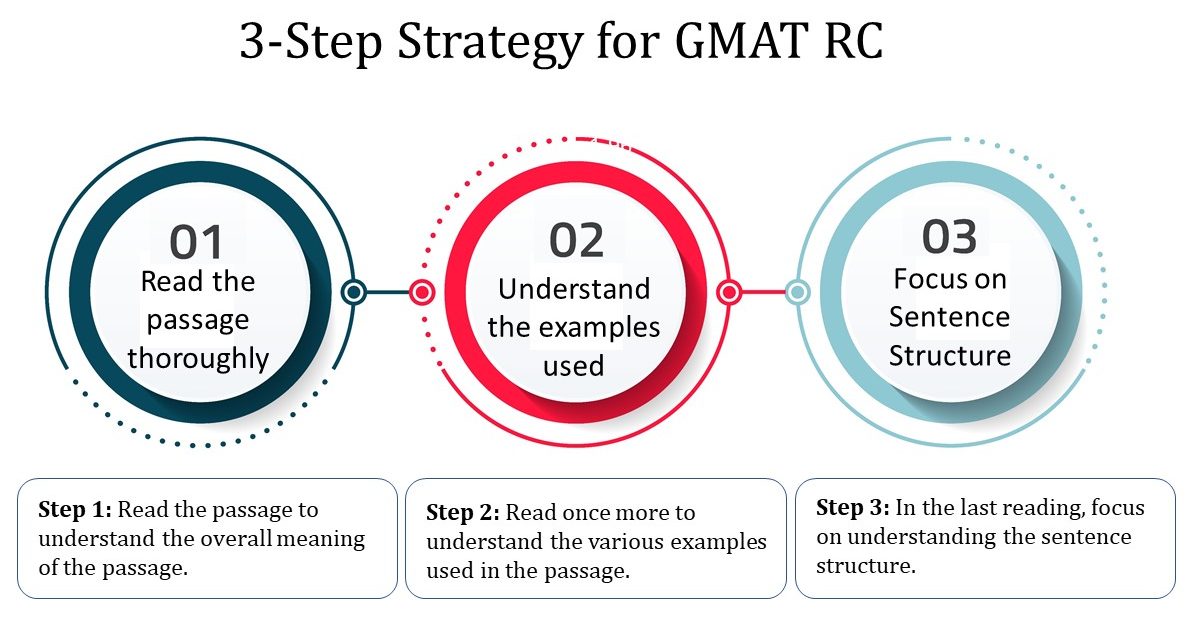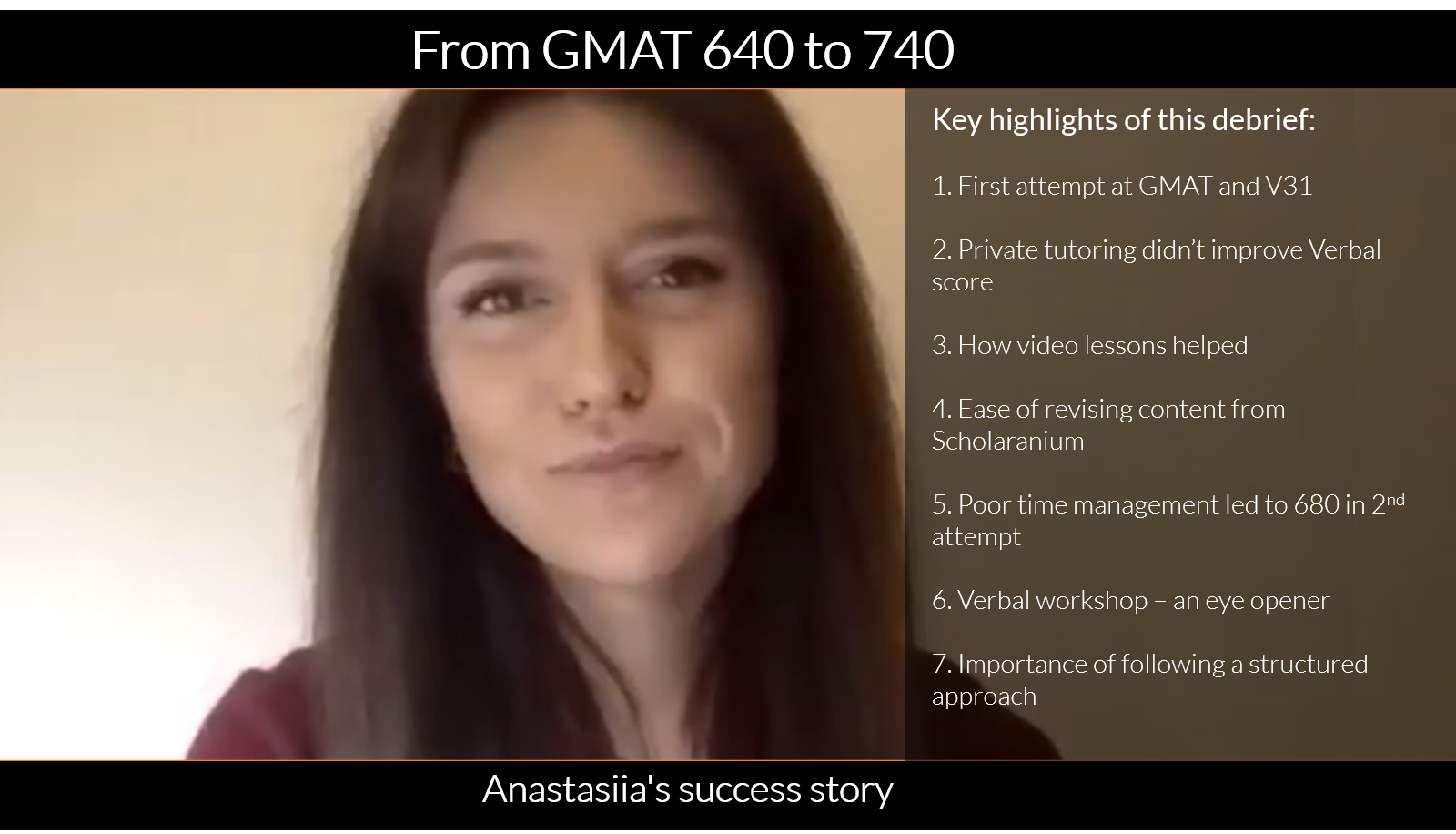Anastasiia, a GMAT non-native speaker, achieved a 100-point score improvement with a verbal focused GMAT strategy. She credits her success to following a meaning-based approach and a structured way of learning to ace the GMAT verbal section. Learn more about how she improved her GMAT score to 740 (Q51 V39) from 640 (Q48 V31) in less than 3 months.
Update: Anastasiia recieved an admit from Columbia Business School
Navigation Suggestions:
- 2:41 – First attempt at GMAT and V31
- 6:42 – Private tutoring didn’t improve Verbal score
- 9:28 – How video lessons helped
- 11:00 – Ease of revising content from Scholaranium
- 12:00 – Poor time management led to 680 in the second attempt
- 18:09 – Verbal workshop: eye opener
- 23:20 – Importance of following a structured approach[/one_third_last]
Rajat: Congratulations on scoring a GMAT 740, with a Q51 V39, tell us a little bit about your background and how did you start preparing for the GMAT?
Thank you, Rajat. What is both a little bit remarkable and interesting to me is that I was scoring a Q50 in all mock tests before my actual attempt. However, despite maintaining similar accuracy on test day, I was able to score a Q51. This may be because of answering more difficult questions as compared to my mock test attempt. Coming to my background, I participated in various math competitions during school, and due to this, I had a strong quant background. Once I decided to give the GMAT, I asked a friend who scored a 760 in the test for his advice. He recommended me to join GMATClub. That is how I started my preparation. Soon aft, I purchased GMAT club quant mock tests as well.
The GMAT is not a test of accuracy, learn more about how the GMAT CAT (Computer Adaptive Test) works.
Rajat: How did you start preparing for the verbal section? And, what resources did you utilize in your first 2 attempts?
Using the Official Guide for Preparation and a Grammar Rules Based approach did not help
Initially, for my first attempt, I used the 2017 OG for verbal preparation. While going through the OG, I found the content and the questions easier than expected. I was able to solve almost all question during practice. I got a wakeup call when I scored a 560 in a mock test. This made me realize that there was something fundamentally wrong with my preparation approach towards the GMAT verbal section. To remedy this, I chose to solicit the services of a reputed private GMAT tutor. We started with GMAT sentence correction as a target area for improvement. However, the tutor’s approach utilized grammar rules-based than meaning or logic oriented.
Still using Gut Feeling rather than a methodical process
Moreover, I couldn’t devote much focus to improving CR and RC, as they were very time consuming to teach in a classroom environment. In the end, I still felt a lack of basic understanding of how to approach different question types. And I still felt that I was answering the question through intuition and gut feeling, rather than arriving at the answer following a methodical process. The above factors took a toll when I appeared for my 2nd GMAT attempt.
My private tutor did not teach me CR and RC strategies as these were time consuming to teach in a classroom environment.
| GMAT Attempt | Final Score | Quant Score | Verbal Score |
| First | 640 | Q48 | V31 |
| Second | 680 | Q50 | V32 |
| Final | 740 | Q51 | V39 |
Rajat: How as your 2nd GMAT test experience?

My 2nd attempt taking the GMAT was a rollercoaster of nerves and emotions. On test day, I selected to begin with the Verbal section. I chose to attempt the verbal section first which was my weaker section with a fresh mind. However, things did not go as planned when I realized that I was left with just 20 mins to answer more than half of the section. Thus, I resorted to randomly marking answers to finish the section in time, some even without reading the question at all.
Test center administrator helped calm down and complete the test
I thought of quitting the rest of the test and canceling my scores soon after during the break between verbal and my next section. However, some helpful advice and soothing words from the test center administrator helped in calming me down. I proceeded to attempt the quant section and ended up with a score of 680 (Q50 V 32). I was pleasantly surprised by this score. And somehow this helped me to treat the GMAT just as any other test.
Read our article on GMAT time management to develop your own GMAT timing strategy.
Rajat: How was your verbal preparation strategy different for your 3rd attempt?
I started using the e-GMAT verbal course exclusively for my 3rd GMAT test attempt. The structured course content which got progressively harder as you moved along the course felt like what I had been looking for all along. Due to my quant mindset, I was always comfortable with thinking logically. The meaning and logic-based approach which is taught for SC as well as the pre-thinking approach for CR gave me the clarity and understanding to approach different types of questions asked in the verbal section.
The verbal workshop provided detailed sub-sectional level feedback on my ability
I also had the opportunity to attend the excellent Verbal Workshop conducted by e-GMAT during this time. I was able to discover my inherently weak RC ability due to the feedback is given after attempting a proctored quiz. My ability in SC and CR was equal to or above 80%. However, my ability in RC was between 30%-50%. To tackle this weakness, I started reading from sources like the Economist.
3-Step strategy for RC
 In this process, I was able to devise a 3-step strategy to answer RC questions.
In this process, I was able to devise a 3-step strategy to answer RC questions.
- Understand meaning
- Understand the examples used in the text
- Understand the sentence structure
Even though this approach required me to spend more time reading the passage, I was able to answer the questions that followed in much less time; thus overall, I improved my timing in RC. This can also be attributed to the fact that spending more time reading the passage initially eliminated the need to refer to the text again. I was able to retain much more information this way.
Attend a free webinar on using the meaning and logic based approach to ace GMAT Sentence Correction
Rajat: How did you utilize Scholaranium during your preparation?
I exclusively used Scholaranium to track the improvement in ability. The skill data made available helped me understand my progress and track my improvement in various sub-sections of the GMAT. I would like to add, that instead of maintaining a manual error log, I used Scholaranium to keep track of the questions that I got wrong on the first attempt. After reviewing the concept files related to such questions, I would attempt these questions again. Scholaranium keeps track of all of these things for you. Also, the e-GMAT learning platform, combined with Scholaranium, served as my go-to platform for the GMAT throughout my preparation.
Rajat: What advice would you give to other GMAT test takers?
Throughout my GMAT preparation and multiple attempts, I have learned a few lessons, and I would like to share them with other prospective GMAT test takers:
- The GMAT is a test of real-life reasoning skills that are required to succeed in Business School, hence your focus while preparing for the GMAT should be on building skills and ability rather than learning shortcuts and tricks.
- As a non-native speaker, I found the meaning-based approach for SC and pre-thinking-based approach for CR to work best. Tricks like skimming the text or reading just the first and last few lines of a text paragraph made me falter in the actual GMAT test.
- The GMAT is a well-designed test with very well-designed question types. It rewards those who utilize the right approach to solve questions.
- To calm your nerves, think of the GMAT as any other mock test attempt, this will help you calm down on test day.
If you want to try out the e-GMAT course that helped Anastasiia make the jump of 100 points from 640 to 740, sign up for our Free Trial. We can also help you with a personalized study plan and give you access to quality online content to prepare. Write to us at acethegmat@e-gmat.com. We are the most reviewed GMAT prep company on GMATClub with more than 1950 reviews (as on Sep 7, 2020).















